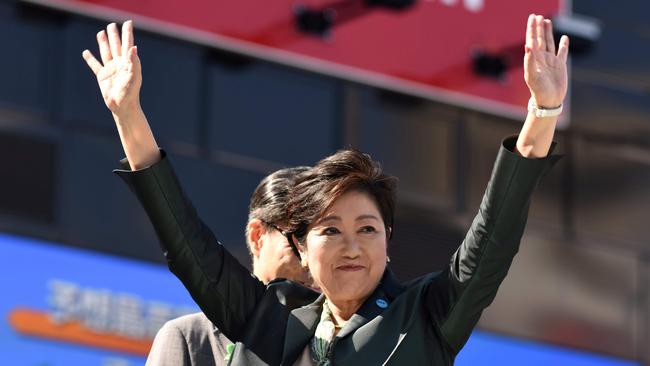‘Lipstick Ninja’ fights Japan’s men’s club
Yuriko Koike is Japan’s most powerful woman and arguably its most popular politician. But her party is in no rush to embrace her rebellious nature.

When Yuriko Koike ran for leader of Japan’s long-dominant Liberal Democratic Party, she described the challenge for women aiming for the top as not so much breaking the “glass ceiling” as dislodging an “iron plate”.
Twelve years after her failed candidacy, that “plate” remains firmly in place as men vie to replace Shinzo Abe, who is quitting as Japan’s longest-serving prime minister because of ill health.
Koike, 68, a former defence minister under Abe, is Japan’s most powerful woman and arguably its most popular politician after she was re-elected last month by a landslide as Governor of Tokyo, the world’s largest city.
She is a conservative nationalist, like Abe, but also a charismatic media-savvy contrast to his dour demeanour. Her approval ratings hit 70 per cent for her handling of the CODID-19 crisis, while his slid below 40 per cent.
She has often been touted as Japan’s potential first female prime minister. But she is ruled out of next month’s party election as she is not an MP and left the ruling LDP following a fallout with Abe.
After her electoral romp last month, analysts predicted she might rejoin the LDP and return to the national fray on the back of her popularity in Tokyo. But the party’s hierarchy is in no rush to embrace her rebellious nature in its male-dominated world — and certainly not at a time of such uncertainty at the top.
“The LDP is not going to roll out the red carpet for her,” said Tobias Harris, a Japan commentator and author of The Iconoclast, a new biography of Abe.
Koike was dubbed the “Lipstick Ninja” for her role as a political assassin taking on the old boys’ network in the LDP under Junichiro Koizumi, who was prime minister from 2001-06. But more disparagingly, others now dismiss her as the “Wandering Bird” because of her party-jumping roots.

One female candidate may join the race. Seika Noda, 59, a backbench MP and former minister, is regarded as having no hope of winning the contest, but as a critic of Abe’s failure to promote women, she may want to make a point about representation.
Just 10 per cent of Japanese MPs are women — one of the world’s lowest rates — and there is only one female minister in Abe’s 18-member cabinet.
The figures for business are almost as bleak. Women hold only 15 per cent of senior commercial positions and earn on average half of their male counterparts. It has the largest gender gap in advanced economies.
Koike has already reached higher office than any woman to run Tokyo, a metropolis with a GDP of $US1.6 trillion, equivalent to the world’s 13th largest economy.
She certainly does not carry the conventional CV of a Japanese politician. She dropped out of university in Japan, moved to Cairo to study Arabic and began her career as a TV news anchor before moving into politics in 1992.
Koike ran for governor of Tokyo in 2016 against the LDP’s will. She quit the party the next year and founded Tokyoites First which swept to power in prefectural elections in 2017 in the only electoral defeat for the LDP since Abe returned to the leadership in 2012.
But Koike then ran up against the LDP machine when she founded the Party of Hope to compete in national elections. It was a chastening experience — the new party fared poorly and was dissolved in 2018 — but Koike rebounded.
“It’s a natural course of action for Koike to return to national politics after securing her place as Tokyo Governor and looking at the (political) situation,” Naoto Nonaka, a professor of politics at Gakushuin University, told Kyodo News after the elections. “Koike is ambitious. She’d want to become prime minister.”
Among the current male line-up, who is likely to succeed Abe? As he left no heir apparent after his surprise announcement on Friday, a power battle is now under way.
Two candidates threw their hats into the ring at the weekend: Fumio Kishida, 63, a former foreign minister once believed to be Abe’s preferred successor, and Shigeru Ishiba, also 63, a former defence minister and Abe rival.
But emerging as favourite is Yoshihide Suga, the abrasive epitome of Japan’s grey ranks of dark-suited men. Suga, 71, the chief cabinet secretary, has served as Abe’s right-hand man and chief political enforcer since 2012.
The Sunday Times






